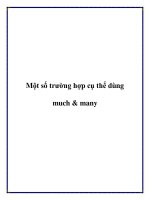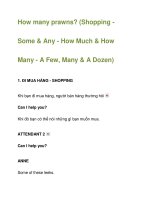Many leaves
Bạn đang xem bản rút gọn của tài liệu. Xem và tải ngay bản đầy đủ của tài liệu tại đây (2.23 MB, 10 trang )
Genre
Nonfiction
Comprehension Skill
Alike and Different
Text Features
• Captions
• Labels
• Glossary
Science Content
Animals and
Plants
Scott Foresman Science 1.3
ISBN 0-328-13741-3
ì<(sk$m)=bdheb < +^-Ä-U-Ä-U
Vocabulary
Extended Vocabulary
antennae
camouflage
flower
leaf
root
stem
compound
conifer
evergreen
float
simple
spines
Picture Credits
Every effort has been made to secure permission and provide appropriate credit for photographic material.
The publisher deeply regrets any omission and pledges to correct errors called to its attention in subsequent editions.
Photo locators denoted as follows: Top (T), Center (C), Bottom (B), Left (L), Right (R), Background (Bkgd).
8 (BR) ©Stephen Haywood/DK Images; 12 (BL) Peter Oxford/Nature Picture Library.
Unless otherwise acknowledged, all photographs are the copyright © of Dorling Kindersley, a division of Pearson.
ISBN: 0-328-13741-3
Copyright © Pearson Education, Inc. All Rights Reserved. Printed in the United States of America.
This publication is protected by Copyright, and permission should be obtained from the publisher prior to any
prohibited reproduction, storage in a retrieval system, or transmission in any form by any means, electronic,
mechanical, photocopying, recording, or likewise. For information regarding permission(s), write to
Permissions Department, Scott Foresman, 1900 East Lake Avenue, Glenview, Illinois 60025.
3 4 5 6 7 8 9 10 V010 13 12 11 10 09 08 07 06 05
What did you learn?
1. Where do leaves grow?
2. What are two kinds of leaves that
grow in woodlands?
3.
by AnnSpines
Rossi help
desert plants. Write to explain
what spines can do for desert
plants. Use words from the book
as you write.
4.
Alike and Different How are
leaves in watery places like leaves
in deserts? How are they different?
What You Already Know
Chameleons use camouflage
to stay safe.
Animals live in different habitats. Animal
body parts help them live. Animals use their
body parts to help them find food. Animals
also have ways to stay safe where they live.
Animals have many ways to stay safe.
Sometimes they help each other. Sometimes
they use camouflage.
Plants are different from animals. Plants do
not have antennae to help them. But plants
are like animals in many ways. Their parts
help them live in different habitats too.
2
Plants have parts. Roots take in water.
They also hold the plant in the ground.
The stem moves water around the plant.
The leaf makes food. The flower makes
seeds. Plants have different kinds of leaves.
Plant parts help plants stay safe. Some
plants use camouflage too.
In this book, you will learn about leaves
that live in different places. You will find
out that different leaves help plants live in
different kinds of places.
3
Leaf Life
There are many different kinds of leaves.
Leaves grow in many places in the world.
They have special parts to help them live
in all these places.
Fanwort
Maple
Eucalyptus
Maritime pine
Fern
Haworthia
4
Rattan palm
Leaves come in many shapes, sizes, and
colors. Some are as small as a baby’s little toe.
But some are as long as a bus! You will see
many kinds of leaves on these pages.
5
Woodland Leaves
Many kinds of leaves grow in woodlands.
Woodlands are places with lots of trees.
Woodlands have simple leaves and compound
leaves. A simple leaf is one leaf on one stem.
A compound leaf has many leaves on one stem.
Ash
Oak
Norway maple
Fern
Maple leaves
Beech
Some leaves change color in the fall. This
happens when the days are short and the
nights are cool. The leaves fall to the ground
by winter. New leaves grow in spring.
6
7
Evergreens stay green all year. They grow
new leaves as they shed their old ones. Holly
and laurel are evergreens. So are most conifers.
Conifers are plants that have cones. Maybe
you have seen a pinecone from a conifer.
Variegated holly
Atlas cedar
Maritime pine
California laurel
Conifer
8
Many evergreens have small leaves with
points. These leaves are better for living where
it is cold. The leaves have wax on them. This
keeps water in. Plants need to keep water in
cold places.
9
Tropical Leaves
The tropics are hot and wet places.
The weather is perfect for palm plants.
Most palms have leaves that look like fans
or feathers. Some palm leaves are very big.
Embauba
Swiss cheese plant
Rattan palm
Elephant ear plant
10
Rain forests and jungles are in the tropics.
Their treetops make a thick cover. Not much
light from the Sun gets to the forest floor.
Leaves that grow under the cover can be
very large. Their size helps them get enough
light to make food.
11
Desert Leaves
Haworthia
Many desert plants have small spines.
These leaves do not give off much water.
Spines also keep plants safe from animals
that want to eat them.
Eucalyptus
Desert rose
Kokerboom
Camelthorn
acacia
12
Some plants store water in thick, waxy
leaves. The waxy leaves help keep water
inside the plant. Plants need to keep water
when they live in hot, dry places.
13
Watery Leaves
Leaves that grow in water can be big or
small. The flat, wide leaves of the water lily
float on water. The giant water lily can grow
to be as big as a car!
Fanwort
Mare’s-tail
Water lily
Water hyacinth
14
The next time you see a plant, look at its
leaves. See their size, shape, and color. Then
think about how the leaves, big or small, help
the plant to live.
15
Extended Vocabulary
Vocabulary
Glossary
compound
antennae
camouflagemade of conifer
compound
more than one part
evergreen
flower
float
leaf
conifer
a tree that
grows cones
simple
root
spines
stem
evergreen
a plant that
has green leaves
What did you learn?
1. Where do leaves grow?
2. What are two kinds of leaves that
grow in woodlands?
3.
Spines help
desert plants. Write to explain
what spines can do for desert
plants. Use words from the book
as you write.
4.
Alike and Different How are
leaves in watery places like leaves
in deserts? How are they different?
all year long
float
stay up on top of water
simple
having one part or only a
few parts
spines
hard plant parts with sharp
points
Picture Credits
Every effort has been made to secure permission and provide appropriate credit for photographic material.
The publisher deeply regrets any omission and pledges to correct errors called to its attention in subsequent editions.
Photo locators denoted as follows: Top (T), Center (C), Bottom (B), Left (L), Right (R), Background (Bkgd).
8 (BR) ©Stephen Haywood/DK Images; 12 (BL) Peter Oxford/Nature Picture Library.
Unless otherwise acknowledged, all photographs are the copyright © of Dorling Kindersley, a division of Pearson.
ISBN: 0-328-13741-3
Copyright © Pearson Education, Inc. All Rights Reserved. Printed in the United States of America.
This publication is protected by Copyright, and permission should be obtained from the publisher prior to any
prohibited reproduction, storage in a retrieval system, or transmission in any form by any means, electronic,
mechanical, photocopying, recording, or likewise. For information regarding permission(s), write to
Permissions Department, Scott Foresman, 1900 East Lake Avenue, Glenview, Illinois 60025.
16
3 4 5 6 7 8 9 10 V010 13 12 11 10 09 08 07 06 05









